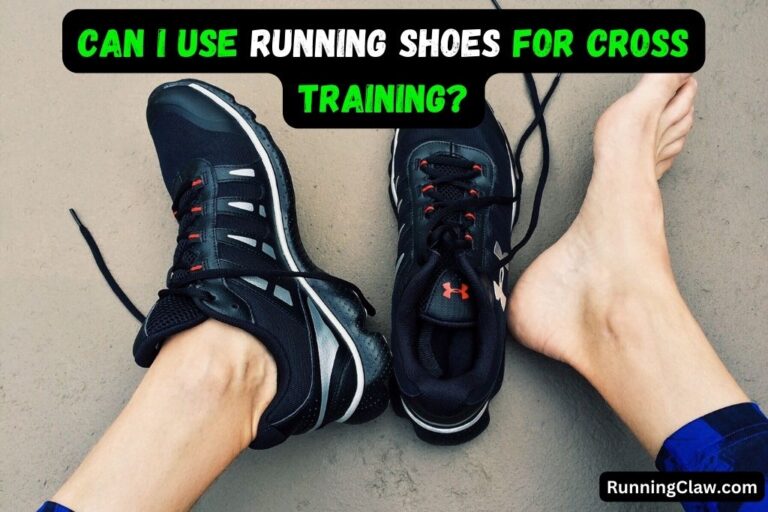Cross-training is a fitness or training method that entails engaging in various physical activities or exercises. Cross-training incorporates various activities to increase overall fitness, prevent overuse injuries, and improve performance in a particular sport or activity rather than concentrating solely on one particular type of exercise.
Like other physical activities, Cross training also requires good support from shoes because a bad grip will ultimately injure you.
Now if you are a regular runner who loves to run to keep himself fit, you might be wondering if you can use running shoes for cross-training or not.
Don’t think too much; read the whole article, and your queries will be resolved. I am very hopeful that this article will help you a lot.
Read | Can I Use Running Shoes for Lifting?
Running Shoes Vs. Cross Training Shoes – Main Differences
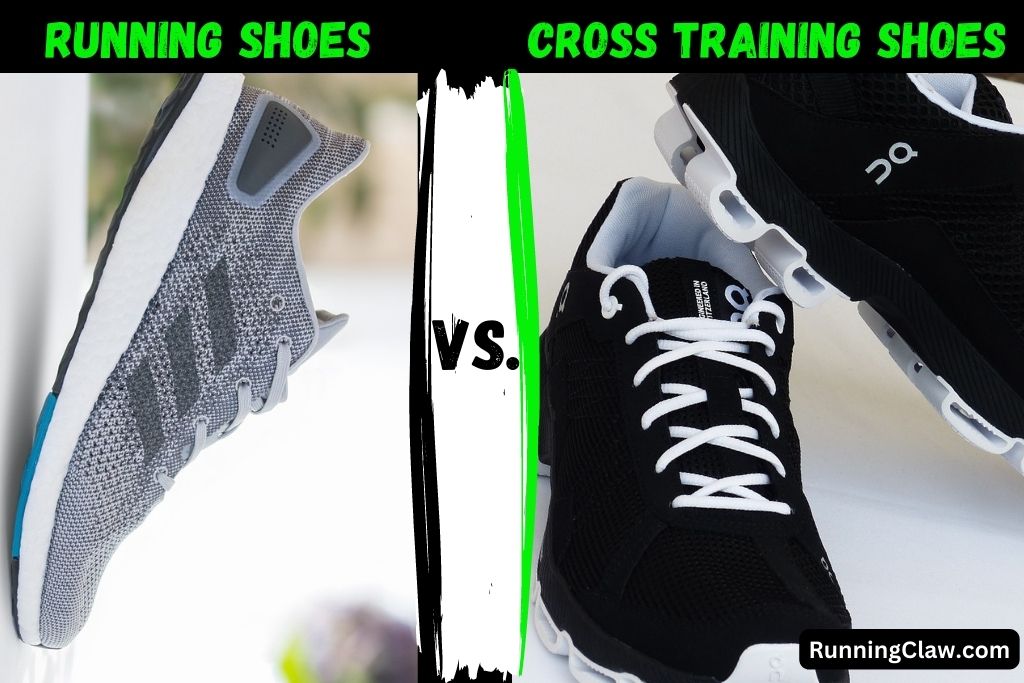
First, I will discuss the main differences between the shoes to make a clear mind map for you.
Running Shoes:
Running shoes have been developed to facilitate heel-to-toe movement. They are typically designed with a higher heel drop, which provides additional cushioning and support in the heel and midfoot regions.
Running shoes are designed to absorb shock due to the high-impact nature of running, where the runner’s feet hit the ground with force equivalent to three times their body weight.
Furthermore, running shoes are typically designed to be lightweight, as runners prefer to avoid the added strain of repeatedly lifting even a slight amount of extra weight during their activity.
The additional weight can accumulate rapidly, leading to increased fatigue during a run that involves 7,000 or more steps. Running shoes typically feature a smooth tread pattern as runners generally do not require significant traction, as they primarily move in a forward direction.
Running shoes are designed with a higher proportion of mesh material than cross-trainers. This is because running generates more heat than a gym workout, and it is essential to maintain cool and dry feet during a run.
Achieving a proper fit is of utmost importance for running shoes. It is important to ensure that a running shoe fits your foot properly before embarking on a long-distance run, as shoes are tailored to accommodate different stride patterns, foot widths, and other factors.
This holds significant importance, particularly for individuals who engage in long-distance running, such as myself. It is recommended to seek assistance from a knowledgeable professional at a nearby running specialty store to ensure proper fitting of running shoes. Investing in a pair of shoes without being certain of their suitability for your needs is not advisable.
Read | Can I Use Running Shoes for Badminton?
Cross Training Shoes:
Cross-training shoes are specifically engineered to facilitate multidirectional movement and a broader range of motion. They are distinguished from running shoes by their flatter sole, which enhances flexibility.
Cross-training shoes are designed to serve as versatile fitness shoes suitable for various activities such as basketball, Zumba, and weightlifting.
Cross-training shoes are designed with additional cushioning in the forefoot region, which protects the wearer upon landing on their toes.
In contrast, running shoes are specifically designed to absorb shock on the heels. The increased firmness of these items renders them more suitable for weight training and facilitates the execution of squats.
Cross trainers feature wider soles extending beyond the width of the shoe’s upper part, in contrast to running shoes. Additional support is required to accommodate augmented lateral movement, such as the abrupt turns executed on a basketball court.
Cross trainers are typically constructed using durable materials that are stronger than those used in running shoes. This enhanced durability allows cross-training shoes to withstand the rigorous workouts often associated with cross-training.
Is it OK to Wear Running Shoes for Cross-Training?
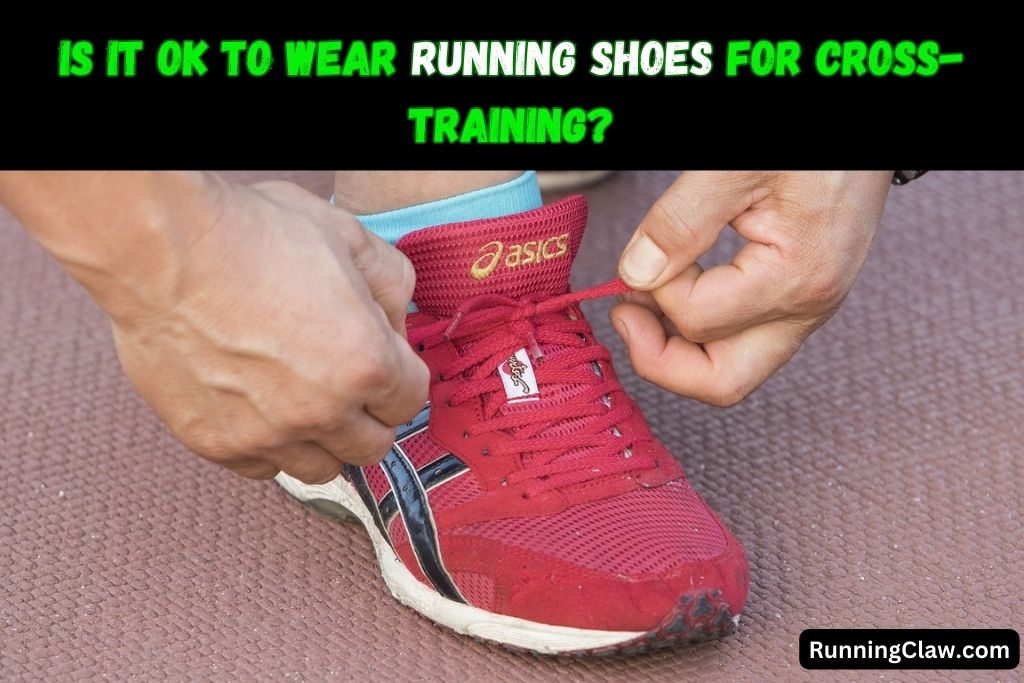
In general, you should avoid using your running shoe for cross-training. Running shoes typically do not have the construction features required to promote strong performance in cross-training workouts.
Assume you’re doing a cross-training workout with lifting and multidirectional work. The thicker midsole of a running shoe limits the stability you get for both training verticals, which can hinder performance.
To provide a more detailed explanation, I will analyze three factors that can restrict the effectiveness of running shoes during cross-training exercises. From a functional perspective, viewing footwear as an instrument for achieving specific objectives and duties can be beneficial.
Lack of Stability:
One of the primary reasons running shoes are not recommended for cross-training is their inadequate stability. Contemporary running shoes typically feature midsoles with substantial thickness, beveled heels, and a moderate degree of toe spring.
In running and walking, certain construction features can enhance the comfort and performance-oriented aspects of running shoes specifically designed for running.
Running shoe features can hinder cross-training performance. A thick foam midsole can make weightlifting unstable.
Running shoes’ midsoles can hinder strength gains in cross-training workouts focusing on weight training.
When lifting weights in shoes with thicker foam, you may feel unbalanced. It’s like lifting heavy things on a thin pillow. Running shoes shouldn’t be used for squatting or deadlifting.
Running shoes’ toe springs can limit stability in cross-training. A shoe’s toe spring is its angle upward. This makes shoes more comfortable for walking and running.
Inadequate Upper Construction of Running Shoes for Cross-Training:
The design and materials utilized in the upper construction of running shoes may also impose restrictions on cross-training activities. The stress exerted on a shoe’s upper during running and cross-training workouts typically varies significantly.
Typically, running shoes feature upper constructions designed specifically to provide lightweight and breathable qualities. Lightweight meshes and uppers will be utilized to promote overall breathability.
Running shoe uppers are designed to withstand stress caused by forward movement in the sagittal plane. This is achieved using lightweight materials and constructing the upper according to the activity.
Cross-training workouts can stress running shoe uppers. Jumping and running will stress your shoes differently.
In a cross-training workout, you do a lot of box jumps, lateral agility, and shuffles. Layered uppers and reinforced sidewalls are best for workouts.
This workout will put more stress on your upper body than a steady-state run. Cross-training shouldn’t tear your shoes’ uppers.
We often overlook the upper construction of our workout shoes, but companies often “get ahead” of issues.
Cross-training shoes have reinforced uppers for durability. For most cross-training, a running shoe’s upper won’t last.
Lack of Traction:
The outsole constructions of running shoes can contribute to their inadequacy during cross-training workouts. The outsole of a shoe is the underside of the footwear and is typically constructed using various rubber materials and tread designs.
Running shoes are designed with specialized tread patterns and may feature exposed foam in various shoe areas. This practice aims to reduce the amount of materials utilized and decrease the overall weight of a shoe. This is because rubber can be a relatively heavy material for a shoe.
Typically, cross-training footwear comprises outsoles of nearly full or full rubber, featuring tread patterns that provide varying degrees of grip in different directions. Typically, distinct patterns are present in the footwear’s forefoot, mid-foot, and heel regions. Alternatively, a uniform pattern may be employed, exhibiting a more aggressive tread.
The diverse tread patterns can enhance traction during forward, backward, and lateral motion. This feature is advantageous as it reduces the likelihood of slippage problems during various cross-training exercises.
Acknowledging that certain cross-training shoes feature exposed foam layers on the outsole is important. It is advisable to consider the surfaces you intend to train, as this may be a significant factor depending on your requirements.
If you train on wooden floors or turf, choose a shoe with a rubber outsole because foam can cause slips. Training on rubber gym floors won’t matter as much.
When choosing cross-training shoes, consider your training and needs. They’ll have subtle differences, like running shoes to better suit your needs.
Can I wear Running Shoes for Cross-Training?
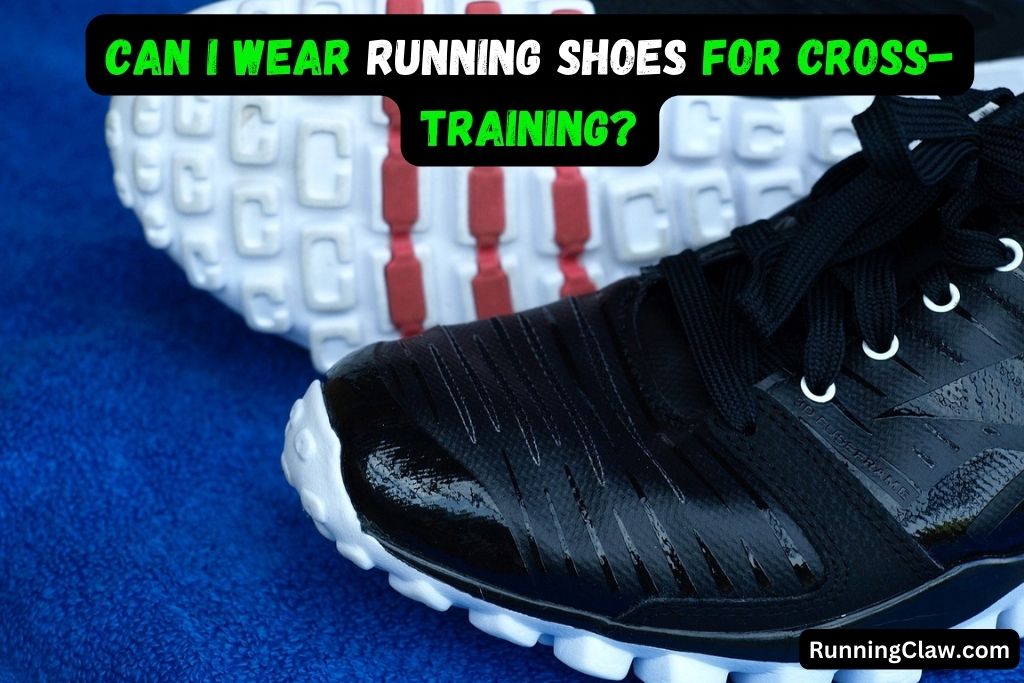
Although running shoes are suitable for certain cross-training activities, they may not be optimal for all forms of exercise. Running shoes are engineered to offer adequate cushioning and support to facilitate forward motion and repetitive heel-to-toe movement typical of running.
Cross-training encompasses a range of physical activities, such as lateral movements, agility exercises, weightlifting, and other dynamic movements. To perform such activities, it may be necessary to utilize footwear that provides enhanced stability, lateral support, and flexibility.
For individuals who intend to participate in physical activities such as weightlifting, high-intensity interval training (HIIT), aerobics, or sports that entail multidirectional movements, it is advisable to utilize cross-training or specialized shoes specifically designed for those activities.
Athletic footwear frequently incorporates supplementary lateral reinforcement, a more secure foundation, and pliable soles to accommodate diverse motions.
If your cross-training regimen mainly comprises running or cardio exercises, it is possible to utilize your running shoes, provided they offer ample support and cushioning.
It is important to note that engaging in cross-training activities can cause wear and tear on your running shoes, potentially shortening their lifespan. To mitigate this, it may be beneficial to invest in a separate pair of shoes specifically for cross-training purposes. This can help to preserve the longevity of your running shoes.
It is crucial to evaluate the precise requirements of your cross-training regimen and opt for footwear that offers a suitable level of support, stability, and flexibility to execute those exercises.
Read | Can I Use Running Shoes for Sports?
Can I Use Running Shoes for Training?
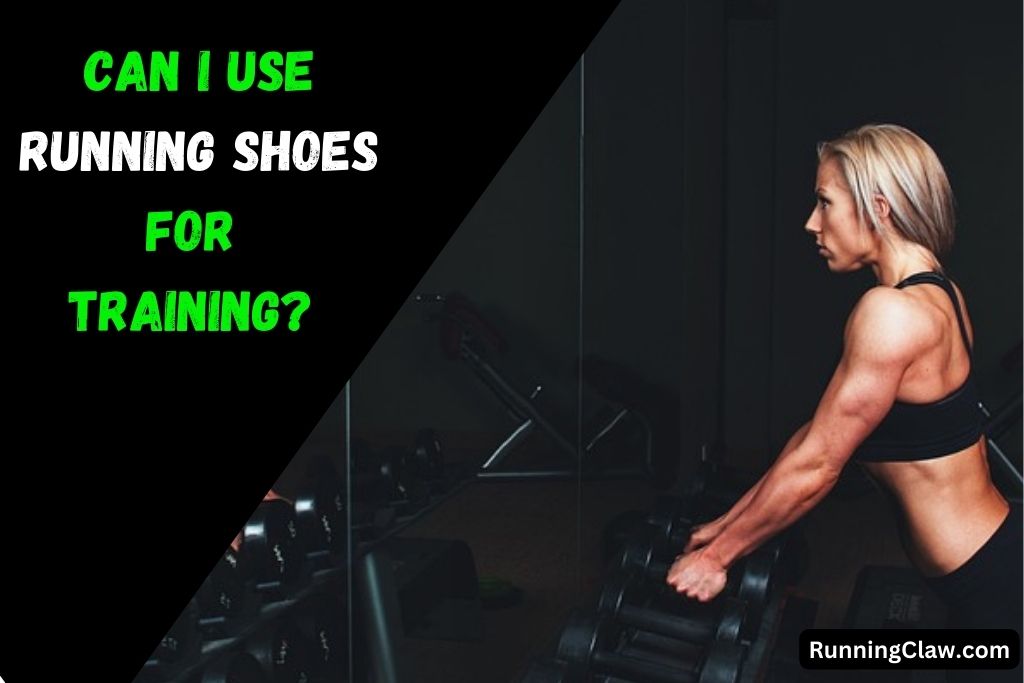
Running shoes are indeed suitable for training purposes. Running shoes are purposefully engineered to provide optimal support and protection for the feet during a wide range of physical training activities, extending beyond mere running. When partaking in physical activities such as running, jogging, gym workouts, cross-training, or any other fitness endeavors, it is essential to equip oneself with appropriate running shoes. These shoes are designed to offer optimal comfort, cushioning, and stability, thereby facilitating a more enjoyable and efficient exercise experience.
Here are some of the key benefits which you can avail by using Running Shoes for Training:
Cushioning:
Running shoes are meticulously engineered to incorporate generous amounts of cushioning material, which effectively mitigates the force generated by activities involving high levels of impact, such as running or jumping.
The utilization of this product effectively mitigates the strain exerted on your joints and muscles, rendering it highly suitable for a diverse array of training exercises.
Support and Stability:
Running shoes offer essential support and stability to the feet and ankles, particularly during lateral movements and activities involving rapid changes in direction.
Lightweight:
Modern running shoes typically possess a lightweight construction, thereby augmenting your agility and velocity while engaging in training sessions.
Flexibility:
The primary purpose of running shoes is to facilitate unrestricted foot movement, a critical requirement for engaging in diverse training activities that necessitate multi-directional motions.
Key Takeaways:
Shoes are useful tools. Running and cross-training shoes are designed for different tasks like hammers and screwdrivers.
Cross-training with running shoes has drawbacks. Cross-training performance is typically hindered by running shoe construction.
Related Articles:
- How to Make Cleats Smell Better?
- What Sports Can Use Metal Cleats?
- Soccer Cleats Vs. Football Cleats
- Can Soccer Cleats Be Used for Football?
- Do Professional Soccer Players get Free Cleats?
- Can Soccer Cleats Be Used for Football?
- Do Puma Soccer Cleats Have A Warranty?
- What is The Difference Between Shoes and Cleats?
- Difference Between Soccer and Football Cleats


